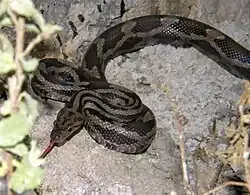Yellow-red rat snake
| Yellow-red rat snake | |
|---|---|

| |
| Scientific classification | |
| Kingdom: | Animalia |
| Phylum: | Chordata |
| Class: | Reptilia |
| Order: | Squamata |
| Suborder: | Serpentes |
| Family: | Colubridae |
| Genus: | Pseudelaphe |
| Species: | P. flavirufa
|
| Binomial name | |
| Pseudelaphe flavirufa (Cope, 1867)
| |
| Synonyms[2] | |
The yellow-red rat snake (Pseudelaphe flavirufa) is a species of snake in the subfamily Colubrinae of the family Colubridae. The species is native to Mexico and Central America. Three subspecies are recognized.
Geographic distribution
Pseudelaphe flavirufa is found in the Mexican states of Campeche, Chiapas, Oaxaca, Puebla, Querétaro, Quintana Roo, San Luis Potosí, Tamaulipas, and Zacatecas. It is also found in the countries Belize, Guatemala, Honduras, and Nicaragua.[2]
Habitat
The preferred natural habitat of Pseudelaphe flavirufa is forest.[1]
Description
Pseudelaphe flavirufa may attain a total length of 1.22 m (4.0 ft), which includes a tail 26 cm (10 in) long. Dorsally, it is yellowish or pale brown with a series of reddish or chestnut-brown spots, which are black-edged and may be confluent into a zigzag stripe. There is an alternating lateral series of smaller spots on each side of the dorsal series. Ventrally, it is yellowish, either plain or with small brown spots.[3]
Reproduction
Pseudelaphe flavirufa is oviparous.[2]
Subspecies
There are three subspecies of Pseudelaphe flavirufa, including the nominotypical subspecies, which are recognized as being valid.[2]
- Pseudelaphe flavirufa flavirufa (Cope, 1867)
- Pseudelaphe flavirufa matudai (H.M. Smith, 1941)
- Pseudelaphe flavirufa pardalina (W. Peters, 1869)
Nota bene: A trinomial authority in parentheses indicates that the subspecies was originally described in a genus other than Pseudelaphe.
Etymology
The subspecific name, matudai, is in honor of Japanese-Mexican botanist Eizi Matuda.[4]
References
- ^ a b Lee, J. (2007). "Pseudelaphe flavirufa". IUCN Red List of Threatened Species. 2007: e.T63879A12716388. doi:10.2305/IUCN.UK.2007.RLTS.T63879A12716388.en. Retrieved 12 November 2021.
- ^ a b c d Species Pseudelaphe flavirufa at The Reptile Database . www.reptile-database.com.
- ^ Boulenger GA (1894). Catalogue of the Snakes in the British Museum (Natural History). Volume II. Containing the Conclusion of the Colubridæ Aglyphæ. London: Trustees of the British Museum (Natural History). (Taylor and Francis, printers). xi + 382 pp. + Plates I–XX. (Coluber flavirufus, p. 39).
- ^ Beolens, Bo; Watkins, Michael; Grayson, Michael (2011). The Eponym Dictionary of Reptiles. Baltimore: Johns Hopkins University Press. xiii + 296 pp. ISBN 978-1-4214-0135-5. (Pantherophis flavirufa matudai, p. 171).
Further reading
- Cope ED (1867). "Fifth Contribution to the Herpetology of Tropical America". Proceedings of the Academy of Natural Sciences of Philadelphia 18: 317–323. (Coluber flavirufus, new species, p. 319).
- Heimes, Peter (2016). Snakes of Mexico: Herpetofauna Mexicana Vol. I. Frankfurt am Main, Germany: Edition Chimaira. 572 pp. ISBN 978-3899731002.
- Lee, J.C. (2000). A Field Guide to the Amphibians and Reptiles of the Maya World: The Lowlands of Mexico, Northern Guatemala and Belize. Ithaca, New York: Comstock Publishing Associates, a Division of Cornell University Press. ISBN 978-0801485879. 416 pp.
- Mertens, Robert, Rosenberg, Hans (1943). "Elaphe flavirufa (Cope), die mexikanische Nachnatter ". Wochenschrift für Aquarien- und Terrarienkunde 37 (3): 60–62. (Pseudoelaphe flavirufus, new combination). (in German).
